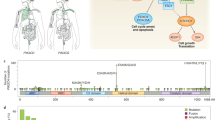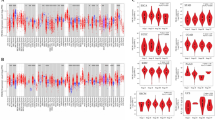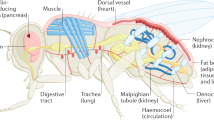Abstract
Tumorigenesis is a complex process, which requires alterations in several tumor suppressor or oncogenes. Here, we use a Drosophila tumor model to identify genes, which are specifically required for tumor growth. We found that reduction of phosphoinositide 3-kinase (PI3K) activity resulted in very small tumors while only slightly affecting growth of wild-type tissue. The observed inhibition on tumor growth occurred at the level of cell-cycle progression. We conclude that tumor cells become dependent on PI3K function and that reduction of PI3K activity synthetically interferes with tumor growth. The results presented here broaden our insights into the intricate mechanisms underling tumorigenesis and illustrate the power of Drosophila genetics in revealing weak points of tumor progression.
This is a preview of subscription content, access via your institution
Access options
Subscribe to this journal
Receive 50 print issues and online access
$259.00 per year
only $5.18 per issue
Buy this article
- Purchase on SpringerLink
- Instant access to full article PDF
Prices may be subject to local taxes which are calculated during checkout





Similar content being viewed by others
References
Bach EA, Ekas LA, Ayala-Camargo A, Flaherty MS, Lee H, Perrimon N et al. (2007). GFP reporters detect the activation of the Drosophila JAK/STAT pathway in vivo. Gene Expr Patterns 7: 323–331.
Bach EA, Vincent S, Zeidler MP, Perrimon N . (2003). A sensitized genetic screen to identify novel regulators and components of the Drosophila janus kinase/signal transducer and activator of transcription pathway. Genetics 165: 1149–1166.
Bilder D, Li M, Perrimon N . (2000). Cooperative regulation of cell polarity and growth by Drosophila tumor suppressors. Science 289: 113–116.
Bilder D, Perrimon N . (2000). Localization of apical epithelial determinants by the basolateral PDZ protein scribble. Nature 403: 676–680.
Britton JS, Lockwood WK, Li L, Cohen SM, Edgar BA . (2002). Drosophila's insulin/PI3-kinase pathway coordinates cellular metabolism with nutritional conditions. Dev Cell 2: 239–249.
Brumby AM, Richardson HE . (2003). scribble mutants cooperate with oncogenic Ras or Notch to cause neoplastic overgrowth in Drosophila. EMBO J 22: 5769–5779.
Cleary JM, Shapiro GI . (2010). Development of phosphoinositide-3 kinase pathway inhibitors for advanced cancer. Curr Oncol Rep 12: 87–94.
Courtney KD, Corcoran RB, Engelman JA . (2010). The PI3K pathway as drug target in human cancer. J Clin Oncol 28: 1075–1083.
Edgar BA, O'Farrell PH . (1990). The three postblastoderm cell cycles of Drosophila embryogenesis are regulated in G2 by string. Cell 62: 469–480.
Gupta S, Ramjaun AR, Haiko P, Wang Y, Warne PH, Nicke B et al. (2007). Binding of ras to phosphoinositide 3-kinase p110alpha is required for ras-driven tumorigenesis in mice. Cell 129: 957–968.
Halfar K, Rommel C, Stocker H, Hafen E . (2001). Ras controls growth, survival and differentiation in the Drosophila eye by different thresholds of MAP kinase activity. Development 128: 1687–1696.
Hennessy BT, Smith DL, Ram PT, Lu Y, Mills GB . (2005). Exploiting the PI3K/AKT pathway for cancer drug discovery. Nat Rev Drug Discov 4: 988–1004.
Huang J, Wu S, Barrera J, Matthews K, Pan D . (2005). The Hippo signaling pathway coordinately regulates cell proliferation and apoptosis by inactivating Yorkie, the Drosophila homolog of YAP. Cell 122: 421–434.
Kaelin Jr WG . (2005). The concept of synthetic lethality in the context of anticancer therapy. Nat Rev Cancer 5: 689–698.
Kango-Singh M, Nolo R, Tao C, Verstreken P, Hiesinger PR, Bellen HJ et al. (2002). Shar-pei mediates cell proliferation arrest during imaginal disc growth in Drosophila. Development 129: 5719–5730.
Knoblich JA, Sauer K, Jones L, Richardson H, Saint R, Lehner CF . (1994). Cyclin E controls S phase progression and its down-regulation during Drosophila embryogenesis is required for the arrest of cell proliferation. Cell 77: 107–120.
Lee T, Luo L . (2001). Mosaic analysis with a repressible cell marker (MARCM) for Drosophila neural development. Trends Neurosci 24: 251–254.
Leevers SJ, Weinkove D, MacDougall LK, Hafen E, Waterfield MD . (1996). The Drosophila phosphoinositide 3-kinase Dp110 promotes cell growth. EMBO J 15: 6584–6594.
Newsome TP, Asling B, Dickson BJ . (2000). Analysis of Drosophila photoreceptor axon guidance in eye-specific mosaics. Development 127: 851–860.
Pagliarini RA, Xu T . (2003). A genetic screen in Drosophila for metastatic behavior. Science 302: 1227–1231.
Prober DA, Edgar BA . (2002). Interactions between Ras1, dMyc, and dPI3K signaling in the developing Drosophila wing. Genes Dev 16: 2286–2299.
Read RD, Cavenee WK, Furnari FB, Thomas JB . (2009). A drosophila model for EGFR-Ras and PI3K-dependent human glioma. PLoS Genet 5: e1000374.
Richardson H, O'Keefe LV, Marty T, Saint R . (1995). Ectopic cyclin E expression induces premature entry into S phase and disrupts pattern formation in the Drosophila eye imaginal disc. Development 121: 3371–3379.
Rodriguez-Viciana P, Warne PH, Dhand R, Vanhaesebroeck B, Gout I, Fry MJ et al. (1994). Phosphatidylinositol-3-OH kinase as a direct target of Ras. Nature 370: 527–532.
Rodriguez-Viciana P, Warne PH, Khwaja A, Marte BM, Pappin D, Das P et al. (1997). Role of phosphoinositide 3-OH kinase in cell transformation and control of the actin cytoskeleton by Ras. Cell 89: 457–467.
Rodriguez-Viciana P, Warne PH, Vanhaesebroeck B, Waterfield MD, Downward J . (1996). Activation of phosphoinositide 3-kinase by interaction with Ras and by point mutation. EMBO J 15: 2442–2451.
Scanga SE, Ruel L, Binari RC, Snow B, Stambolic V, Bouchard D et al. (2000). The conserved PI3'K/PTEN/Akt signaling pathway regulates both cell size and survival in Drosophila. Oncogene 19: 3971–3977.
Stewart M, Murphy C, Fristrom JW . (1972). The recovery and preliminary characterization of X chromosome mutants affecting imaginal discs of Drosophila melanogaster. Dev Biol 27: 71–83.
Verdu J, Buratovich MA, Wilder EL, Birnbaum MJ . (1999). Cell-autonomous regulation of cell and organ growth in Drosophila by Akt/PKB. Nat Cell Biol 1: 500–506.
von Stein W, Ramrath A, Grimm A, Muller-Borg M, Wodarz A . (2005). Direct association of Bazooka/PAR-3 with the lipid phosphatase PTEN reveals a link between the PAR/aPKC complex and phosphoinositide signaling. Development 132: 1675–1686.
Weinkove D, Neufeld TP, Twardzik T, Waterfield MD, Leevers SJ . (1999). Regulation of imaginal disc cell size, cell number and organ size by Drosophila class I(A) phosphoinositide 3-kinase and its adaptor. Curr Biol 9: 1019–1029.
Wu M, Pastor-Pareja JC, Xu T . (2010). Interaction between Ras(V12) and scribbled clones induces tumour growth and invasion. Nature 463: 545–548.
Acknowledgements
We would like to thank G Hausmann and J Zartman for comments on the manuscript; A Smith for help with experiments; and H Stocker, the Bloomington Stock Center, the National Institute of Genetics (NIG) and the Vienna Drosophila RNAi Center (VDRC) for fly strains. This work was supported by an FEBS Long-term Fellowship to MW, the Swiss National Science Foundation and the Kanton of Zurich.
Author information
Authors and Affiliations
Corresponding author
Ethics declarations
Competing interests
The authors declare no conflict of interest.
Additional information
Supplementary Information accompanies the paper on the Oncogene website
Rights and permissions
About this article
Cite this article
Willecke, M., Toggweiler, J. & Basler, K. Loss of PI3K blocks cell-cycle progression in a Drosophila tumor model. Oncogene 30, 4067–4074 (2011). https://doi.org/10.1038/onc.2011.125
Received:
Revised:
Accepted:
Published:
Issue date:
DOI: https://doi.org/10.1038/onc.2011.125
Keywords
This article is cited by
-
Polarity scaffolds signaling in epithelial cell permeability
Inflammation Research (2021)
-
Rab11b-mediated integrin recycling promotes brain metastatic adaptation and outgrowth
Nature Communications (2020)
-
Autophagy suppresses Ras-driven epithelial tumourigenesis by limiting the accumulation of reactive oxygen species
Oncogene (2017)
-
Microenvironmental autophagy promotes tumour growth
Nature (2017)
-
The transcription factor Ets21C drives tumor growth by cooperating with AP-1
Scientific Reports (2016)



